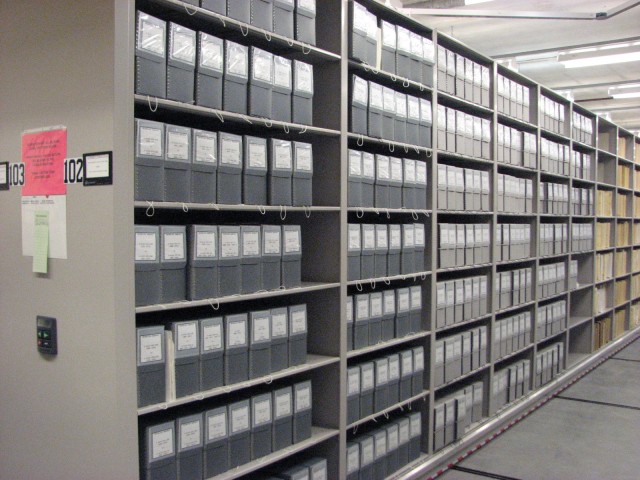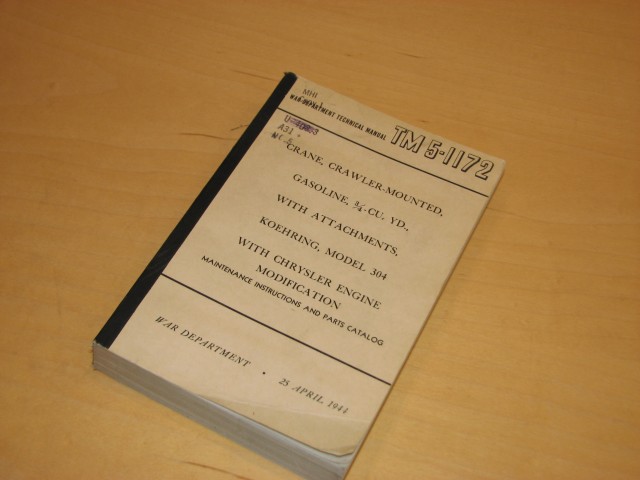February of 2010 completes seven years of Operation Iraqi Freedom, which began in March of 2003. During the first months of that war, most American forces were deployed through the Persian Gulf. Original plans called for bringing the 4th Infantry Division into action from the north, but international diplomatic considerations required that it also be committed from the south via the gulf. Such redeployment required readjustment to logistical capabilities. To make sure our forces were well supplied, many military agencies did their part -- including the Army Heritage and Education Center.
Shortly after seizing the Iraqi port of Umm Qasr in late March 2003, coalition forces discovered an old World War II-era - crane, which was critical to making the port operational, thus facilitating the shipment of supplies into the country. Unfortunately the crane was inoperable; our logisticians, though skilled in using modern high tech equipment, did not know how to fix this artifact from an earlier era. The following month, the Army turned to USAHEC and its U. S. Army Military History Institute (MHI) to request portions of Technical Manual (TM) 5-1172, dated April 25, 1944. This particular technical manual pertained to the make and model of the inoperable crane. The MHI was able to electronically transmit scans of the requested information and diagrams. With the scans in hand, the Army was able to get both the crane and the port facilities operational.
This is just one example of the numerous requests for superseded Army publications that MHI has been able to provide in support of Operation Iraqi Freedom and Operation Enduring Freedom.
Likewise, the Army Corps of Engineers often seeks old TMs and Army Regulations (AR) in conjunction with issues, primarily environmental, arising from Base Realignment and Closures (BRAC). Again, MHI has been able to provide virtually all of the publications requested.
TMs and ARs represent just two of the categories of Department of the Army (DA) publications issued by direction of the Secretary of the Army for the administration and operation of the Army.
DA publications, and their predecessors, War Department publications, fall into three major classifications: administrative publications such as Army Regulations, Special Regulations, Bulletins, Circulars, General and Special Orders, and Pamphlets; doctrinal, training and organizational publications such as FMs, Army Training and Evaluation Programs, Training Circulars, Tables of Organization and Equipment, and Tables of Allowances; and technical and equipment publications such as Technical Manuals, Technical Bulletins, Supply Manuals, etc.
Obtaining current Army publications is relatively easy to accomplish. However, in the past, locating superseded War Department and DA publications proved much more problematic, which led attendees at an Army Historical Research Collection Management Workshop to conclude in November 1999 that Aca,!A"there is a very real need for a single-source custodian of superseded Army series publications, such as ARAca,!a,,cs, FMAca,!a,,cs and TMAca,!a,,cs.Aca,!A?
Today that single-source custodian is MHI. It maintains a collection of over 337,000 Army publications representing 54 separate and distinct publication series that span the period from the late 1700s to the present. Consisting of over 6,000 linear feet, MHIAca,!a,,cs Army publications collection is augmented by nearly 22,000 digital copies with additional digitized Army publications being added weekly.
To assist patrons, MHI maintains nearly 3,600 pages of finding aids on its website identifying individual Army publications contained in MHIAca,!a,,cs holdings. For military historians this collection is especially important as it allows them to trace the evolution of the ArmyAca,!a,,cs doctrine, organizational structure, equipment, uniforms, and weapons. The collection, especially the technical manuals, is equally important to Army curators in terms of the care, maintenance and preservation of military artifacts within their holdings. Not surprisingly, collectors, living historians and re-enactors also find MHIAca,!a,,cs Army publications collection particularly beneficial, as do veterans and their families. Likewise, Army librarians throughout the world have found the collection quite helpful in supporting their patrons. Thus, the serving Army, veterans, and historians all benefit from this great collection. In the future, when looking for a superseded Army publication, think MHI.
ABOUT THIS STORY: Many of the sources presented in this article are among 400,000 books, 1.7 million photos and 12.5 million manuscripts available for study through the U.S. Army Military History Institute (MHI). The artifacts shown are among nearly 50,000 items of the Army Heritage Museum (AHM) collections. MHI and AHM are part of the: Army Heritage and Education Center, 950 Soldiers Drive, Carlisle, PA, 17013-5021.






Social Sharing